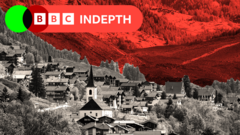In Switzerland’s picturesque Loetschental valley, community leader Matthias Bellwald strolls past familiar faces, exchanging smiles and handshakes. However, a dark shadow looms over the area as just two months earlier, his home village of Blatten was obliterated. A dramatic glacier and mountain collapse forced the evacuation of 300 residents. They lost their beloved homes, local church, and family-run businesses to an unforgiving landscape.
Lukas Kalbermatten, whose family operated a hotel for generations, witnessed the destruction with a heavy heart: "The essence of our village, with narrow alleys and cherished childhood memories, is now gone." He now resides temporarily in Wiler, while Bellwald coordinates a massive cleanup and rebuilding effort. Initial estimates place the cost of reconstructing Blatten around $1 million per former resident.
Public donations have aided recovery, with Switzerland’s federal government promising support. However, a major question arises: is rebuilding worth the steep financial and environmental costs? A 2007 report indicated that real protection against natural disasters could require expenditures up to six times the current annual budget, causing many to reconsider the viability of saving mountain communities.
In Switzerland, where two-thirds of land is mountainous, the Alps are a vital component of national identity. Each valley is steeped in its own history and culture. The loss of Blatten raises concerns among residents about the erosion of these alpine traditions. As Kalbermatten reflects, “The word ‘heimat’ embodies memories from childhood, which would be lost if we abandon our roots.”
Conversely, retired businessman Fernando Lehner recalls the shocking moment of the landslide: "We knew a landslide was possible, but the reality was unimaginable.” Climate scientists assert that global warming is exacerbating the instability of the Alps, mainly due to the thawing of permafrost, which acted to stabilize steep slopes.
Research shows that extreme weather events and landslides are becoming more frequent and unpredictable, raising alarms for other alpine villages also in danger. In the Graubünden region, evacuation efforts have already taken place, with more residents facing uncertain futures.
The editorial voice of Switzerland has begun asking tough questions. The Neue Zürcher Zeitung recently articulated the dilemma over wealth redistribution: should urban taxpayers continue to fund risky mountain communities that may soon need costly evacuations? This ongoing debate underscores the complex relationship between people, place, and climate change.
Traditions unique to alpine culture, such as the Tschäggättä masks of Loetschental, could vanish with depopulation. Kalbermatten fears losing the very essence of their heritage, similar to areas in northern Italy that have become ghost towns.
Polls show a national affection for Switzerland’s stunning landscape. Yet, as the country confronts the reality of more frequent geological happenings, perspectives on relocation are evolving. As Boris Previsic, an expert on mountain culture, points out, Switzerland must adapt to new challenges: “We thought we tamed nature, but now we need to prepare for unpredictable events.”
The relentless recovery efforts in Blatten are crucial not just for homes, but for the lives once intertwined with its existence. As construction crews work to clear debris and rebuild, residents unite in shared bonds of resilience and hope, knowing that although their homes may change, the collective spirit of the community remains steadfast.
Lukas Kalbermatten, whose family operated a hotel for generations, witnessed the destruction with a heavy heart: "The essence of our village, with narrow alleys and cherished childhood memories, is now gone." He now resides temporarily in Wiler, while Bellwald coordinates a massive cleanup and rebuilding effort. Initial estimates place the cost of reconstructing Blatten around $1 million per former resident.
Public donations have aided recovery, with Switzerland’s federal government promising support. However, a major question arises: is rebuilding worth the steep financial and environmental costs? A 2007 report indicated that real protection against natural disasters could require expenditures up to six times the current annual budget, causing many to reconsider the viability of saving mountain communities.
In Switzerland, where two-thirds of land is mountainous, the Alps are a vital component of national identity. Each valley is steeped in its own history and culture. The loss of Blatten raises concerns among residents about the erosion of these alpine traditions. As Kalbermatten reflects, “The word ‘heimat’ embodies memories from childhood, which would be lost if we abandon our roots.”
Conversely, retired businessman Fernando Lehner recalls the shocking moment of the landslide: "We knew a landslide was possible, but the reality was unimaginable.” Climate scientists assert that global warming is exacerbating the instability of the Alps, mainly due to the thawing of permafrost, which acted to stabilize steep slopes.
Research shows that extreme weather events and landslides are becoming more frequent and unpredictable, raising alarms for other alpine villages also in danger. In the Graubünden region, evacuation efforts have already taken place, with more residents facing uncertain futures.
The editorial voice of Switzerland has begun asking tough questions. The Neue Zürcher Zeitung recently articulated the dilemma over wealth redistribution: should urban taxpayers continue to fund risky mountain communities that may soon need costly evacuations? This ongoing debate underscores the complex relationship between people, place, and climate change.
Traditions unique to alpine culture, such as the Tschäggättä masks of Loetschental, could vanish with depopulation. Kalbermatten fears losing the very essence of their heritage, similar to areas in northern Italy that have become ghost towns.
Polls show a national affection for Switzerland’s stunning landscape. Yet, as the country confronts the reality of more frequent geological happenings, perspectives on relocation are evolving. As Boris Previsic, an expert on mountain culture, points out, Switzerland must adapt to new challenges: “We thought we tamed nature, but now we need to prepare for unpredictable events.”
The relentless recovery efforts in Blatten are crucial not just for homes, but for the lives once intertwined with its existence. As construction crews work to clear debris and rebuild, residents unite in shared bonds of resilience and hope, knowing that although their homes may change, the collective spirit of the community remains steadfast.




















